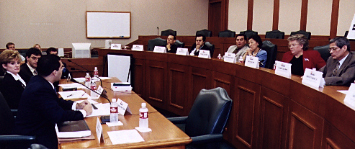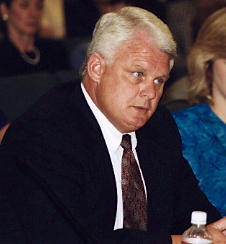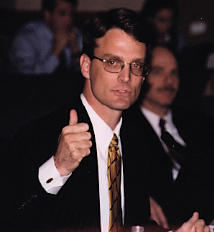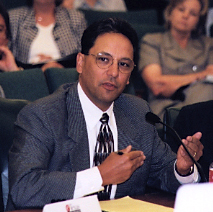|
June 28, 2000
Full e-Texas Commission Meeting
Members Present
Comptroller Carole Keeton Rylander, Dr. Wendy Lee Gramm, Hector De Leon, Elizabeth Lang-Miers, John Fainter, Gerald B. Smith, Dr. Thomas Saving, Rosendo Perra, Noe Fernandez, Massey Villarreal and Bill Hammond
Executive Summary
Progress reports from three task forces -- Competitive Government, Government Performance and Human Resource Management -- were presented to the e-Texas Commissioners. Guest speakers made presentations on performance and accountability in Texas government, human resources management in a competitive market, and modeling the federal FAIR Act in Texas.
Discussion
Hector De Leon called the meeting to order and encouraged "feed back from the community on e-Texas initiatives." Dr. Wendy Gramm thanked Comptroller Rylander for the opportunity to serve on the Commission and observed "the comptroller is outworking us all."
Comptroller Rylander recognized Representative Carl Isett, Representative Henry Cuellar and UT Chancellor Ed Sharpe and thanked them for attending today's meeting. Comptroller Rylander explained that Commissioner Laura Keith was unable to attend today's meeting because she's about to have a baby, and that Co-chairman Tom Leoffler had a previous training conflict and would be unable to attend.

Comptroller Carole Keeton Rylander and her e-Texas Commission listened to testimony at their June 28 meeting.
|
The following are highlights of these presentations:
GOVERNMENT PERFORMANCE TEAM
Government Performance Task Force Commissioner John Fainter presented the task force progress report. Mr. Fainter began his presentation by reading a quote from Comptroller Rylander's inaugural speech: "Government closest to the people is most accountable and most responsive…state government exists for the good of the people of Texas. All authority of government derives from the people. We are here because of, and for them. Once that is understood, our mission is clear: Let us make state government do what Texans want."
Mr. Fainter then gave a brief legislative history of Texas efforts to improve accountability in state government. In 1991, the Texas Legislature passed HB 2001 that implemented strategic planning, requiring each state agency to prepare long-range plans that included a statement of its mission, goals, objectives and strategies. In 1995, the Texas Legislature adopted some refinements to the planning and budgeting system, and passed legislation requiring the governor to adopt goals for each functional area of state government. In response, the Governor's office issued Vision Texas: The Statewide Strategic Planning Elements for the Texas State Government. Currently, Vision Texas contains eight statewide goals, 81 state-level benchmarks, and 38 state-level service categories.
Mr. Fainter then provided a summary of trends in government performance. Government should emphasize outcomes instead of outputs. Measures of outcomes, or results, provide citizens and elected officials with objective data for informed decisions about the allocation of public funds. Texas state government has been slow to adopt pay for performance. At least 72 percent of US companies offer their workers pay for performance. A number of state and local governments are adopting a "balanced scorecard" approach. This approach requires the organization to choose performance measures representing four perspectives: financial concerns, customer service, internal business processes, and learning and growth perspectives. Another trend is "performance partnerships." These are collaborative efforts among government agencies to achieve specific results in certain program areas.
Mr. Fainter then made the following recommendations for the Government Performance Team:
- Improve state government's accountability, coordination and performance. The state should provide user-friendly information to the general public on agency appropriations, performance measures, statewide goals, benchmarks and service categories.
- Institute pay for performance for state employees.
- Texas should use "mystery shopper" techniques to ensure high-quality customer service.
- Texas should conduct a state government, customer satisfaction survey and produce a customer satisfaction index.
- State officials should periodically spend time in a customer service function.
- The state should co-locate small agencies and consolidate or outsource specific administrative functions to gain significant economies of scale while improving service.
Ara Merjanian, Director of Planning and Development for the Office of the Governor, made a presentation on performance and accountability. Mr. Merjanian said Texas is a leader among states in performance-based budgeting, performance reporting, and monitoring and auditing. Currently, 30 Texas state agencies can give performance bonuses to employees. Merjanian stressed the need for flexibility for managers to manage for results. Managers need to be nimble when dealing with technology and demographic changes. Merjanian cautioned against any new requirements that restrict managers from getting results.
Dr. Deborah L. Kerr, Director with the State Auditor's Office, gave an overview of the "balanced scorecard" as implemented by the State Auditor's Office. Dr. Kerr said nine out of 10 companies fail to execute strategy, 85 percent of executives spend less than one hour a month on strategy, and only 5 percent of workers understand strategy. Dr. Kerr then did a hand's on demonstration of a software product the State Auditor's Office uses to track projects.
Representative Cuellar provided the commission with a legislative history of performance based budgeting in Texas and its value as a management tool. Representative Cuellar described performance based budgeting as the "quiet revolution of 1991" to reform government in Texas. The National Conference of State Legislatures has recognized Texas as one of the leading budgeting systems in the country. Agencies using performance based budgeting as a management tool "get better information and make better decisions."
Commissioner Noe Fernandez offered the following observations:
- Bonuses are good for the morale of state employees,
- Salaries for state employees are very low,
- State government is dangerously low on pay for performance, and
- We need to look at tenure in higher education.
HUMAN RESOURCE MANAGEMENT TASK FORCE
Bill Eggers made the presentation to the commission on the findings of the Human Resource Management Task Force. Mr. Eggers described the new world of work as the "Knowledge Economy." The most important organizational assets are intellectual assets: the knowledge contained in the minds of workers, as well as in computer networks and databases.
Mr. Eggers made the following observations concerning the challenges the State faces in human resources:
- An aging workforce (average age is 41),
- High attrition rate at 17 percent,
- Salary disparities in certain markets like Austin, and
- The system was designed for a 30-year career employee, a category of worker that is dwindling rapidly.
How Texas measures up against other states in human resources:
- Hiring / firing flexibility — Best,
- HR decentralization - Best,
- Employee incentives - Top 5,
- Job classifications/ Broad-banding Middle,
- Compensation — Middle, and
- Ability to contract/outsource - Good.
The following are the recommendations from the Human Resource Management Task Force:
- Give managers more flexibility to attract and retain good employees;
- Give employees more flexibility such as telecommuting and increased health care and retirement options;
- Restructure HR practices with an eye to the new worker–the free agent–for example, give more portability of pensions and faster advancement opportunities;
- Improve recruitment by moving from paper to web-based and cut hiring cycle time by 50%;
- Use technology to save money and enhance processes; and
- Train employees for the new role of public employee.
Kelli Dan, State Classification Office, provided the committee with a number of interesting facts and figures:
- In fiscal year 1999 the state of Texas spent $11 billion (27%) on human resources.
- 10% of the state workforce can retire in the next 5 years.
- By 2008 the state workforce will be 46% hispanic, 37% white, 9% black and 8% Asian/other.
- 53 percent of the state workforce is female. Women currently earn 91% of men salaries in comparable jobs.
- Turnover rate of state employees is 17 percent and costs the state between $120 million to $250 million.
- The State of Texas spent $2.6 billion for contingent workers in 1999.

Gary Anderson, Executive Director, Texas
Public Employees Association
|
Gary Anderson, Executive Director for the Texas Public Employees Association, offered the following information to the commission:
- Competition for qualified workers is intense. The current state employee turnover rate is 17.58 percent and twice that, or 35 percent, for employees under the age 30. In some agencies, turnover is as high as 33 percent.
- Compensation disparity between public and private industry is 20 percent.

Skip Stitt,
President, Competitive Government Strategies
|
Skip Stitt, President of Competitive Government Strategies, offered the commission some general advice in terms of human resources practices in the new economy. He recommended the state cut both human resources paperwork and job classifications by 50 percent. In addition decentralize human resources professionals and turn them into head hunters for new talent.
COMPETITIVE GOVERNMENT TASK FORCE
Commissioner Bill Hammond began his remarks by saying we have exciting opportunities to make changes. Mr. Hammond suggested picking five or six agencies that currently answer to a board or commission. Replace the boards and commissions with an executive director and give the director the freedom to run the operations. Set standards and expectations for the director and review performance on an annual basis. We could pay a strong director as much as $250,000 a year. If they produce, renew their contract. If they fail, fire them.
Mr. Hammond went on to describe the history of competitive government institutions in Texas:
- The Competitive Cost Review (CCR) 1987, process too lengthy and cumbersome;
- Council on Competitive Government (CCG) 1991, saved the state over $39 million; and
- Comptroller Carole Keeton Rylander's Yellow Pages Test, over a half-dozen projects underway or completed.
"Government should do no job if there's a business in the Yellow Pages that can do that job better and at a lower cost," Comptroller Rylander said, explaining her Yellow Pages Test.
The Competitive Government Task Force made the following recommendations:
- Apply the Yellow Pages Test systematically across state government.
- Do an inventory of functions that could be performed by the private sector.
- Transition to performance-based contracts.
- Use state-of-the-art technology to reduce the cycle time in contracting for services.
- Modernize the procurement system.
- Expand Activity Based Costing into more areas of state government.
- Take steps to ensure a level playing field in public-private competitions.
- Use employee adjustment and facilitation strategies to ease the transition to competition.

State Representative Carl Isett
|
Representative Isett said that Activity Based Costing and competition is a "good value for government." He observed that "the magic is not in the outsourcing but the magic is in the competition."
Stephen Sorrett, Director of Privatization and Government Contract Services, Grant Thornton LLP provided the commission with background and history of the Federal Activities Inventory Reform Act (FAIR). Mr. Sorest observed that every position studied in the Defense department saved 20% or a total of $6 billion. He felt the FAIR Act process fit easily into the Texas model of e-Government.
Co-Chairman Hector De Leon adjourned the meeting and announced the next commission meeting will be July 20, 2000.
|

